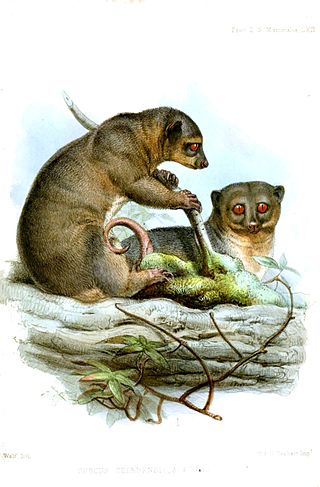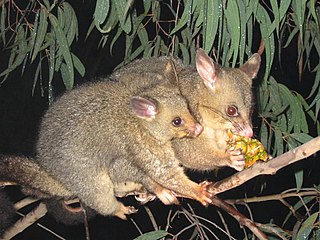
Phalangeriformes is a paraphyletic suborder of about 70 species of small to medium-sized arboreal marsupials native to Australia, New Guinea, and Sulawesi. The species are commonly known as possums, gliders, and cuscus. The common name "possum" for various Phalangeriformes species derives from the creatures' resemblance to the opossums of the Americas. However, although opossums are also marsupials, Australasian possums are more closely related to other Australasian marsupials such as kangaroos.

The common spotted cuscus, also known as the white cuscus, is a cuscus, a marsupial that lives in the Cape York region of Australia, New Guinea, and nearby smaller islands.

Phalanger is a genus of possums. Its members are found on New Guinea, the Maluku Islands, other nearby small islands, and Australia's Cape York Peninsula. They are marsupials of the family Phalangeridae, and are one of the four genera whose species are commonly referred to as cuscuses.

The bear cuscuses are the members of the genus Ailurops. They are marsupials of the family Phalangeridae.

The ornate cuscus or Molluccan cuscus is a species of marsupial in the family Phalangeridae. It is endemic to Indonesia, where it is found on the North Maluku islands of Halmahera, Bacan and Morotai, at elevations from sea level to 1000 m.

Rothschild's cuscus, also called the Obi Island cuscus, is a species of marsupial in the family Phalangeridae. It is endemic to the islands of Obi, Bisa and Obilatu in the Obi Islands of Maluku province, Indonesia.

The Admiralty Island cuscus or Manus Island spotted cuscus is a species of marsupial in the family Phalangeridae. It is endemic to the Admiralty Islands of Papua New Guinea. It is the smallest member of the genus Spilocuscus, and the female has a black back, while the male has blackish spots on a white background. Both genders have rufous heads.

The Waigeou cuscus or Waigeou spotted cuscus is a species of marsupial in the family Phalangeridae. It is endemic to the island of Waigeo in Indonesia, and consequently the spelling Waigeo cuscus is often used instead of Waigeou cuscus. Unlike all other members of the genus Spilocuscus, both genders are whitish with black spots. It remains fairly common, but its small range makes it vulnerable to habitat loss and hunting.

The black-spotted cuscus is a species of marsupial in the family Phalangeridae. It is among the largest members of the family, only being surpassed by the bear cuscus. It is a relatively colourful species found in forests of northern New Guinea. It is threatened by hunting and habitat loss, and has already disappeared from large parts of its range. Consequently, it is rated as Critically Endangered by IUCN.

Dwarf cuscus (Strigocuscus) is a nocturnal, arboreal marsupial genus in the family Phalangeridae found only in Sulawesi and some of its surrounding small offshore islands. Due to the unique biogeography of Sulawesi giving sub-regions of endemism, it is likely that there are several different species or subspecies as yet to be described by science. So far, the genus contains the following species:

The Talaud bear cuscus is a species of marsupial in the family Phalangeridae. It is endemic to Salibabu Island in the Talaud Islands, Indonesia. Its natural habitat is subtropical or tropical dry forests. The species is considered Critically Endangered, with a small population size and heavy hunting pressure on both islands where it occurs, as well as continued habitat degradation.

The Phalangeridae are a family of mostly nocturnal marsupials native to Australia, New Guinea, and Eastern Indonesia, including the cuscuses, brushtail possums, and their close relatives. Considered a type of possum, most species are arboreal, and they inhabit a wide range of forest habitats from alpine woodland to eucalypt forest and tropical jungle. Many species have been introduced to various non-native habitats by humans for thousands of years.

Cuscus is the common name generally given to the species within the four genera of Australasian possum of the family Phalangeridae with the most tropical distribution:

The blue-eyed spotted cuscus or Biak spotted cuscus is a species of critically endangered marsupial in the family Phalangeridae.

The Biak–Numfoor rain forests is a tropical moist forest ecoregion in Indonesia. The ecoregion covers the islands of Biak, Supiori, Numfoor, and several smaller islands, which lie in Cenderawasih Bay north of Yapen and New Guinea.














